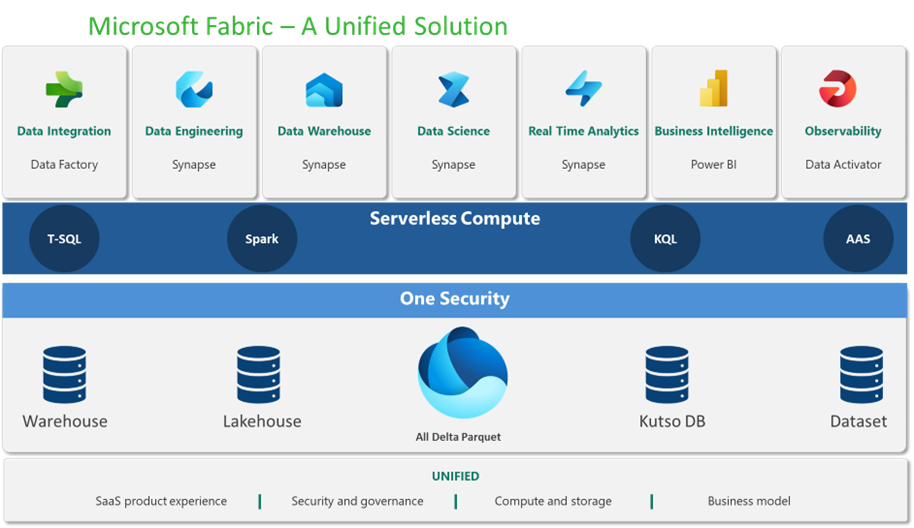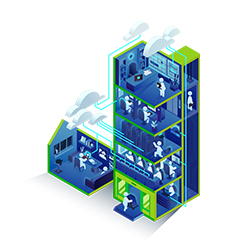Author: Angad Soni
Chief Architect, Business Applications & Data Modernization
Long View
Fabric is an end-to-end, unified analytics platform that brings together all the data and analytics tools that organizations need. It integrates technologies like Azure Data Factory, Azure Synapse Analytics, and Power BI into a single unified product, empowering data and business professionals alike to unlock the potential of their data and lay the foundation for the era of AI.
But Fabric is not just a collection of services. It is also a platform that leverages the power of OpenAI, co-pilot and Onelake datahub to enhance the analytics experience and enable new scenarios.
The history and evolution of Fabric
Fabric is the result of Microsoft’s vision and innovation in the data and analytics space. It builds on the strengths and capabilities of existing Microsoft products, such as Azure Data Factory, Azure Synapse Analytics, and Power BI, and integrates them into a seamless and coherent platform.
Azure Data Factory is a cloud-based data integration service that allows users to create data-driven workflows for orchestrating and automating data movement and transformation. It was launched in 2014 as a successor to SQL Server Integration Services (SSIS), and has since evolved to support over 100 connectors to various data sources and destinations, as well as advanced features such as mapping data flows, data lineage, and Azure Monitor integration.
Azure Synapse Analytics is a cloud-based analytics service that combines enterprise data warehousing and big data analytics. It was launched in 2019 as a rebranding and expansion of Azure SQL Data Warehouse, which was itself launched in 2015 as a cloud-based version of SQL Server Parallel Data Warehouse (PDW). Azure Synapse Analytics offers a unified experience for ingesting, preparing, managing, and serving data for immediate business intelligence (BI) and machine learning needs.
Power BI is a cloud-based business analytics service that provides interactive visualizations and BI capabilities. It was launched in 2015 as a standalone product, after being initially introduced as an add-on for Excel in 2013. Power BI enables users to connect to various data sources, transform and model data, create reports and dashboards, and share insights with others.
Fabric brings together these three products into a single platform that provides a unified experience for all the data professionals involved in the analytics process. Fabric also adds new features and capabilities that leverage the power of OpenAI, co-pilot and Onelake datahub.

OpenAI
OpenAI is a research organization that creates and publishes artificial intelligence systems that can generate natural language, images, code, and more. One of their most popular products is OpenAI Codex, which powers GitHub Copilot, a service that helps developers write better code faster by suggesting lines or entire functions as they type.
Fabric integrates with OpenAI Codex to provide intelligent assistance for data professionals. For example, Fabric users can use natural language queries to explore their data in OneLake datahub, and get suggestions for SQL queries or Power BI reports based on their intent. Fabric users can also use OpenAI Codex to generate code snippets for Azure Data Factory pipelines or Azure Synapse Analytics notebooks, saving time and effort.
Co-pilot
Co-pilot is a Fabric feature that helps users discover and use the best data items for their analytics needs. Co-pilot uses machine learning to analyze the user’s context, such as their role, project, workspace, or query, and recommend relevant data items from OneLake datahub. Co-pilot also provides guidance on how to use the recommended data items, such as how to join them, filter them, or visualize them.
Co-pilot helps users find the right data faster and easier, without having to browse through hundreds of data items or rely on manual searches. Co-pilot also helps users avoid using outdated or inaccurate data items, by highlighting the endorsement status, freshness, and quality of the recommended data items.
OneLake datahub
OneLake datahub is the core of Fabric’s lake-centric approach. It provides customers with one data lake for the entire organization at scale, one copy of data for use across multiple analytical engines, one security model living natively with the data in the lake (coming soon), and a centralized OneLake data hub for data discovery and management.
OneLake datahub organizes all the Fabric data items in an intuitive way, and automatically indexes them for discovery, sharing, governance, and compliance. OneLake datahub serves developers, business analysts, and business users alike, helping eliminate pervasive and chaotic data silos created by different developers provisioning and configuring their own isolated storage accounts.
OneLake datahub also provides open access to all of the Fabric items through existing ADLS Gen2 APIs and SDKs. Users can access their data in OneLake through any tool compatible with ADLS Gen2 just by using a OneLake URI instead.
Conclusion
Fabric is more than just a collection of services. It is a platform that leverages the power of OpenAI, co-pilot and onelake datahub to deliver AI-powered analytics. By using Fabric, users can benefit from:
- A unified experience for all the data and analytics tools that organizations need
- A no infrastructure component that allows users to start using Fabric right away without any installation or configuration
- A simple and easy-to-understand interface that caters to both technical and non-technical users
- Intelligent assistance for natural language queries and code generation
- Personalized recommendations for relevant and trustworthy data items
- A unified and scalable data lake with easy discovery and management
- A seamless integration with existing tools and APIs
If you want to learn more about Fabric and how it can help you transform your analytics experience, leave a comment below.

Subscribe to our newsletter for the latest updates.